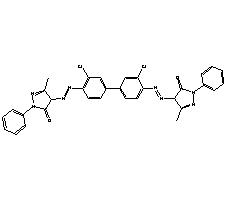Pigmentorange 13
| Produktname | PIGMENT ORANGE 13 |
| Synonyme | CIPigment Orange 13; CIPO13; PO13; PO13 |
| CI | 21110 |
| CAS-NR. | 3520-72-7 |
| EINECS | 222-530-3 |
| Molekulargewicht | 623.49 |
| Molekularformel | C32H24Cl2N8O2 |
| Dichte | 1,42 g/cm3 |
| Farbe | Orangenpulver |
![]()
Molekülstrukturformel:

Echtheitseigenschaften von Pigment Orange 13:
| Lichtgeschwindigkeit | 3-4 |
| Hitzebeständigkeit (℃) | 180 |
| Wasserbeständigkeit | 4-5 |
| Ölbeständigkeit | 5 |
| Säurebeständigkeit | 4-5 |
| Alkalibeständigkeit | 4-5 |
| Alkoholbeständigkeit | 3-4 |
Hauptanwendung: Tinte auf Wasserbasis, Offsettinte, Tinte auf Lösungsmittelbasis, Kunststoff, Farbe, Textildruck
Wir haben verschiedene Pigmentqualitäten und -eigenschaften, um den unterschiedlichen Kundenanforderungen gerecht zu werden. Bitte geben Sie Ihre Anwendung und Anforderungen an, damit wir sie entsprechend empfehlen können. E-Mail: sy@sypigment.com
Produktbeschreibung von Pigment Orange 13:
Pigmnet Orange 13 is used for coloring of ink, plastic, rubber, pigment printing paste and cultural and educational supplies; the shade is similar to that of Pigmentorange 34, and the translucent specific surface area is 35-40m2/g (Irgalite Orange D specific surface area is 39m2/g); plastic PVC coloring is not recommended due to migration; Natural rubber is resistant to vulcanization and migration, so it is suitable for rubber coloring; detergent resistant, good water resistance, used for swimming articles, sponge, viscose fiber pulp, packaging ink and metal decorative paint coloring, heat resistance (200 ℃); and for rubber industry.
Pigment Orange 13 is an organic compound and an azo compound. It is a commercial orange pigment. It is also classified as a diarylide pigment, being derived from 3,3'-dichlorobenzidine. It is closely related to Pigment Orange 3, wherein the two phenyl groups are replaced by p-tolyl groups.
Pigment Orange 13 is coloristically very similar to Pigment Orange 34, but generally somewhat more yellow. Application of Pigment Orange 13 in polyolefins is limited. The pigment is very fast to detergents. It is also employed in viscous spin dyeing and in mass dyeing. The graphics industry, on the other hand, uses pigment orange 13 to an appreciable extent for packaging printing inks. Its fastness to light is average but the stability of pigmented prints to a number of organic solvents is excellent or almost perfect. Similarly, the prints are fast to paraffin, butter, and soap. They withstand heat very well and are stable up to 200°C. Pigment orange 13 thus lends itself to metal decor printing, provided its light-fastness suits the purpose. Likewise, its resistance to clear lacquer coatings and to sterilization is excellent.
TDS (Pigment Orange 13) MSDS (Pigment Orange 13)Synonyme
- Pigmentorange 13
- 4,4′-((3,3′-Dichloro-[1,1′-biphenyl]-4,4′-diyl)bis(diazene-2,1-diyl))bis(3-methyl-1-phenyl-1H-pyrazol-5(4H)-one)
- SCHEMBL2641824
- AKOS025311122
- AKOS030627473
- Pigment Orange 13; 4,4′-[(3,3′-Dichloro[1,1′-biphenyl]-4,4′-diyl)bis(azo)]bis[2,4-dihydro-5-methyl-2-phenyl-3H-pyrazol-3-one]
- C.I.21110
- P0596
- H10760
- W-109143
IUPAC-Name: 4-[[2-chloro-4-[3-chloro-4-[(3-methyl-5-oxo-1-phenyl-4H-pyrazol-4-yl)diazenyl]phenyl]phenyl]diazenyl]-5-methyl-2-phenyl-4H-pyrazol-3-one
InChI: InChI=1S/C32H24Cl2N8O2/c1-19-29(31(43)41(39-19)23-9-5-3-6-10-23)37-35-27-15-13-21(17-25(27)33)22-14-16-28(26(34)18-22)36-38-30-20(2)40-42(32(30)44)24-11-7-4-8-12-24/h3-18,29-30H,1-2H3
InChIKey: HKYYDLYCGBDWSB-UHFFFAOYSA-N
Kanonisches Lächeln: CC1=NN(C(=O)C1N=NC2=C(C=C(C=C2)C3=CC(=C(C=C3)N=NC4C(=NN(C4=O)C5=CC=CC=C5)C)Cl)Cl)C6=CC=CC=C6
| Name des Anwesens | Eigentumswert |
| Molekulargewicht | 623.5 |
| XLogP3-AA | 7.6 |
| Anzahl der Wasserstoffbrückenspender | 0 |
| Anzahl der Wasserstoffbindungsakzeptoren | 8 |
| Rotierbarer Bindungszähler | 7 |
| Genaue Masse | 622.1399274 |
| Monoisotopische Masse | 622.1399274 |
| Topologische polare Oberfläche | 115 Ų |
| Schwere Atomzahl | 44 |
| Formale Ladung | 0 |
| Komplexität | 1090 |
| Anzahl der Isotopenatome | 0 |
| Definierte Anzahl von Atom-Stereozentren | 0 |
| Undefinierte Anzahl von Atom-Stereozentren | 2 |
| Definierte Bond-Stereocenter-Anzahl | 0 |
| Undefinierter Bond Stereocenter Count | 0 |
| Anzahl der kovalent gebundenen Einheiten | 1 |
| Verbindung ist kanonisiert | Ja |






